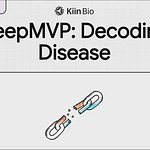What’s slowing you down? Let us tackle it.
Chai Discovery Team has unveiled Chai-2, a next-generation, multimodal AI platform for zero-shot de novo antibody and miniprotein design. By integrating atomic-level generative models with rapid lab-in-the-loop validation, Chai-2 tackles a longstanding challenge in therapeutic discovery: reliably generating functional binders from scratch without high-throughput screens.
Key Innovations and Capabilities:
1. Zero-Shot Design & Validate Workflow
Design: Prompt Chai-2 with an epitope or binding-site definition. The model generates diverse, atomically resolved binder candidates, spanning scFvs, VHHs, and miniproteins, entirely from scratch.
Validate: Advance ≤20 designs per target directly to wet-lab testing in a single 24-well plate. No large-scale screening needed.
Iterate: High hit rates (up to 68% for miniproteins; ~16% for antibodies) compress the design-to-validation cycle to under two weeks.
2. Multimodal Generative AI Foundation
Chai-2’s all-atom generative models:
Predict 3D structures and binder-target complexes with twice the experimental accuracy of its predecessor.
Simultaneously design sequence and structure for various binding modalities.
Generalise across 52 diverse, novel targets with no known binders in the Protein Data Bank.
3. Scalable, Generalisable Approach
Unlike traditional pipelines, Chai-2:
Requires no known starting antibodies or retraining for each target.
Leverages advanced structure prediction (DockQ ≥ 0.8) for atomic-level precision.
Routinely generates structurally novel binders with high sequence diversity.
4. Applications in Drug Discovery
De Novo Antibody Discovery: Achieves ~16% hit rates across diverse, unseen antigens which is a 100× improvement over previous methods.
Miniprotein Binders: Delivers picomolar affinities against challenging targets, including the first computationally designed TNFα binder.
Cross-Reactivity Engineering: Generates binders simultaneously targeting human and cyno homologs.
Flexible Design: Supports precise epitope targeting and format switching (scFv ↔ VHH).
5. Performance & Validation
Chai-2’s performance is demonstrated through:
Rigorous experimental binding assays (BLI) confirming specific, high-affinity interactions.
Independent off-target screens, polyreactivity profiling, and developability assessments.
Structure and sequence novelty checks ensuring true de novo generation.
6. Limitations and Future Work
Current focus: Epitope-specific binders at the antibody or miniprotein level; expansion to complex modalities like bispecifics and antibody-drug conjugates is underway.
Challenges: Enhancing immunogenicity prediction, manufacturability profiling, and atomic-level structure accuracy for highly flexible CDR loops.
Roadmap: Develop next-generation design modules to support fully integrated pipelines for multi-specific, cross-reactive, and IND-ready biologics.
Why It Matters
Chai-2 shifts biologics discovery from high-throughput screens to intentional, programmable molecular engineering. By reliably designing validated binders in a single computational-experimental cycle, Chai-2 sets the stage for an era where zero-shot AI design can deliver drug-like leads faster than ever imagined.










